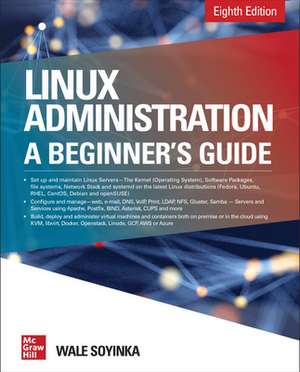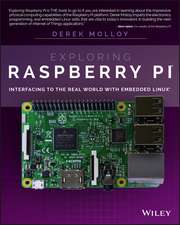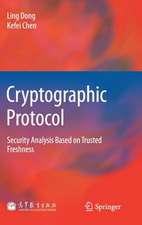Linux Administration: A Beginner's Guide, Eighth Edition
Autor Wale Soyinkaen Limba Engleză Paperback – 28 apr 2020
Gain Essential Linux Administration Skills Easily
Effectively set up and manage popular Linux distributions on individual servers and build entire network infrastructures using this practical resource. Fully updated to cover the latest tools and techniques, Linux Administration: A Beginner’s Guide, Eighth Edition features clear explanations, step-by-step instructions, and real-world examples. Find out how to configure hardware and software, work from the command line or GUI, maintain Internet and network services, and secure your data. Performance tuning, virtualization, containers, software management, security, and backup solutions are covered in detail.
- Install and configure Linux, including the latest distributions from Fedora, Ubuntu, CentOS, openSUSE, Debian, and RHEL.
- Set up and administer core system services, daemons, users, and groups.
- Manage software applications from source code or binary packages.
- Customize, build, or patch the Linux kernel.
- Understand and manage the Linux network stack and networking protocols, including TCP/IP, ARP, IPv4, and IPv6.
- Minimize security threats and build reliable firewalls and routers with Netfilter (iptables and nftables) and Linux.
- Create and maintain DNS, FTP, web, e-mail, print, LDAP, VoIP, and SSH servers and services.
- Share resources using GlusterFS, NFS, and Samba.
- Spin-up and manage Linux-based servers in popular cloud environments, such as OpenStack, AWS, Azure, Linode, and GCE.
- Explore virtualization and container technologies using KVM, Docker, Kubernetes, and Open Container Initiative (OCI) tooling.
- Download specially curated Virtual Machine image and containers that replicate various exercises, software, servers, commands, and concepts covered in the book.
Preț: 182.46 lei
Preț vechi: 259.62 lei
-30% Nou
Puncte Express: 274
Preț estimativ în valută:
34.91€ • 36.45$ • 28.90£
34.91€ • 36.45$ • 28.90£
Carte tipărită la comandă
Livrare economică 04-15 aprilie
Preluare comenzi: 021 569.72.76
Specificații
ISBN-13: 9781260441703
ISBN-10: 1260441709
Pagini: 608
Dimensiuni: 185 x 229 x 36 mm
Greutate: 0.95 kg
Ediția:8
Editura: McGraw Hill Education
Colecția McGraw-Hill
Locul publicării:United States
ISBN-10: 1260441709
Pagini: 608
Dimensiuni: 185 x 229 x 36 mm
Greutate: 0.95 kg
Ediția:8
Editura: McGraw Hill Education
Colecția McGraw-Hill
Locul publicării:United States
Cuprins
PART 1: Introduction and Installation
Chapter 1: Introduction to Linux, Distributions and FOSS
Chapter 2: Installing Linux in a Server
Chapter 3: Deploying Linux Servers in the Cloud
PART 2: Single-Host Administration
Chapter 4: The Command Line
Chapter 5: Managing Software
Chapter 6: Managing Users and Groups
Chapter 7: Booting and Shutting Down
Chapter 8: File Systems
Chapter 9: Core System Services
Chapter 10: The Linux Kernal
Chapter 11: Knobs and Dials: API (Virtual) File Systems
PART 3: Networking and Security
Chapter 12: TCP/IP for System Administrators
Chapter 13: Network Configuration
Chapter 14: Linux Firewall (Netfilter)
Chapter 15: Local Security
Chapter 16: Network Security
PART 4: Internet Services
Chapter 17: DNS
Chapter 18: FTP
Chapter 19: Appache Web Server
Chapter 20: SMTP
Chapter 21: POP and IMAP
Chapter 22: Voice Over IP (IP)
Chapter 23: The Secure Shell
PART 5: Intranet Services
Chapter 24: Network File System
Chapter 25: Samba
Chapter 26: Distributed File Systems
Chapter 27: Lightweight Directory Access Protocol (LDAP)
Chapter 28: Printing
Chapter 29: Dynamic Host Configuration Protocol (DHCP)
Chapter 30: Virtualization
Chapter 31: Backups
PART 6: Appendices
Appendix A: Creating a Linux Installer on Flash/USB Devices
Appendix B: Using the Demo Virtual Machine Images and Cloud Images
Chapter 1: Introduction to Linux, Distributions and FOSS
Chapter 2: Installing Linux in a Server
Chapter 3: Deploying Linux Servers in the Cloud
PART 2: Single-Host Administration
Chapter 4: The Command Line
Chapter 5: Managing Software
Chapter 6: Managing Users and Groups
Chapter 7: Booting and Shutting Down
Chapter 8: File Systems
Chapter 9: Core System Services
Chapter 10: The Linux Kernal
Chapter 11: Knobs and Dials: API (Virtual) File Systems
PART 3: Networking and Security
Chapter 12: TCP/IP for System Administrators
Chapter 13: Network Configuration
Chapter 14: Linux Firewall (Netfilter)
Chapter 15: Local Security
Chapter 16: Network Security
PART 4: Internet Services
Chapter 17: DNS
Chapter 18: FTP
Chapter 19: Appache Web Server
Chapter 20: SMTP
Chapter 21: POP and IMAP
Chapter 22: Voice Over IP (IP)
Chapter 23: The Secure Shell
PART 5: Intranet Services
Chapter 24: Network File System
Chapter 25: Samba
Chapter 26: Distributed File Systems
Chapter 27: Lightweight Directory Access Protocol (LDAP)
Chapter 28: Printing
Chapter 29: Dynamic Host Configuration Protocol (DHCP)
Chapter 30: Virtualization
Chapter 31: Backups
PART 6: Appendices
Appendix A: Creating a Linux Installer on Flash/USB Devices
Appendix B: Using the Demo Virtual Machine Images and Cloud Images
























